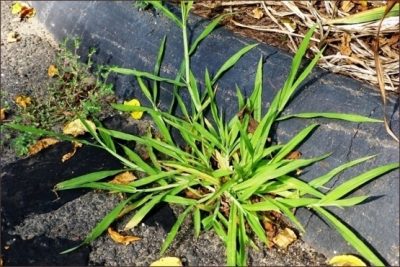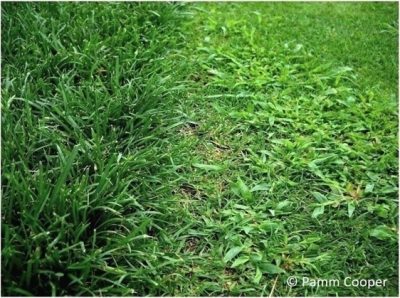Whenever areas of a lawn become thin, due to salt, drought, disease, insect, or other sources of damage, weeds are likely to move in. One of the likely invaders will be crabgrass. A warm-season annual grass, it persists by producing seeds the previous year that will germinate the next spring after a few consecutive days of temperatures of at least 60ºF. Usually in Connecticut, this means crabgrass normally germinates sometime after forsythia bloom and before lilac or dogwood bloom.

Unless new turf grass is established in thinned areas of the lawn, crabgrass or other weeds will probably come in. The trick is to establish the new grass in a small window of time before the crabgrass seeds dropped last summer germinate and crowd out the desirable grasses. It can be helpful to allow lawn grasses to grow to a height of 3” to shade out the crabgrass seedlings so they won’t be able to compete successfully with the desired turf grasses. This will probably not be an effective control strategy if the stand of turf grass is thin, so spring/fall seeding coupled with proper fertilizer timing and irrigation may be needed.
A pre-emergent herbicide can be used if it was not possible to establish turf grass in the spring, or if the fall seeded areas did not fill in adequately. This herbicide needs to be watered in before crabgrass seed germination to form a barrier on the soil surface that will prevent the crabgrass from becoming established. In late summer or early fall, the desired grass can then be seeded. Read the label of the pre-emergent herbicide used. Some have a residual effect of three to four months and may mean that no grass (including desirable turf) will be able to develop from seed as long as the herbicide remains effective.
One organic pre-emergent herbicide that can be effective is corn gluten meal. This non-chemical alternative, a by-product of corn milling, affects root development of crabgrass and other plants that produce seedlings. Corn gluten meal contains 10% nitrogen but to be effective it must be applied at a rate that will be the equivalent of two pounds of nitrogen per 1,000 square feet. It also requires a period of no irrigation or rain for a week after weed seeds have germinated. If rain occurs, root development can then occur and weed seedlings will have two pounds of nitrogen to use, helping them outgrow desirable grasses in the right growing conditions.
Two pre-emergent herbicides are available for homeowner use that will allow turf grass seed to develop normally, while preventing crabgrass from coming in. These products can be applied at the same time the lawn is seeded. One product is called Tupersan™, which has the active ingredient siduron. After six weeks, siduron products can be re-applied to the newly seeded areas to ensure crabgrass will not get a foothold in any thin areas. Do not apply a third time. The other product available for residential use is called Tenacity™. The active ingredient is mesotrione, and is a synthetic form of a compound found in the bottlebrush plant. This product provides both pre-emergent and post-emergent control of both weedy grasses and many broadleaf weeds and can be used when seeding desirable grasses. Read the label to determine the length of effectiveness and apply products at the correct rate to avoid damaging existing grass and new grass seedlings.
Post-emergent herbicides are best used when crabgrass plants are young and have not tillered (produced side shoots). Applications made when crabgrass has 2-4 leaves are the most effective. These herbicides are typically sprayed on the plants and do not damage desirable grasses if they are used at the correct rates. Products with the active ingredient Quinclorac provide excellent control of crabgrass are available for residential use at any growth stage and are also very safe when applied to new seedlings. Many organic products are better suited to target crabgrass where desirable turf will not also be sprayed, and may not be as effective as synthetic herbicides. Metharsenate (MSMA), dithiopyr, and fenoxyprop are also excellent for post-emergent crabgrass control when used before plants get to a more mature stage of development. Always read labels before applying any herbicides.
As with all weeds, crabgrass will be able to get in only where turf has thinned, gone dormant, or even died due to improper cultural practices, weather, insects or other problems. Herbicides are only a tool, and their use should be limited to areas where crabgrass has been a chronic issue, such as along a roadside where salt may have killed some turf over the winter. If a lawn has thinned out somewhat and cannot be reseeded before crabgrass will germinate, the use of a pre-emergent product may then be desirable. It is not always necessary or desirable to treat an entire lawn with any pesticide.
If roadside turf is killed because of salt damage in the winter, try seeding these areas with either a fine-leaved fescue or a turf-type tall fescue that is more salt-tolerant than Kentucky bluegrass and perennial ryegrass. Or consider landscaping along roads with perennials and shrubs that are salt-tolerant instead of dealing with repeated thinning of turf due to salt damage.

Cool season lawn grasses (Kentucky bluegrass, perennial ryegrass, fescues) should not be fertilized during the summer months, especially with fast-release nitrogen sources. As cool season grasses slow down or go dormant in hot weather, crabgrass can gain a foothold because it is an annual grass on a short time table. Fertilizer applied when crabgrass is at its maximum growth potential in summer, especially a fertilizer containing phosphorus, encourages growth and seed head development of this troublesome weed. Mowing may help stop seed head development, but if seed heads are present, bagging clippings can be helpful. Wash both the wheels and the underside of the mower afterwards to prevent seeds from being transported the next time around. Mowing while grass is dry will help prevent weed seeds from sticking to shoes and mower wheels and ending up elsewhere.

Keep in mind that sound lawn care practices and proper turf grass species selection go a long way in keeping desirable grasses healthy and better able to withstand many potential problems. A dense, healthy lawn kept at a height of 2½ to 3” is a better defense against crabgrass invasion than any herbicide.

the area cut lower on the right has crabgass coming in.
Contact the UConn Home and Garden Education Center for herbicide or cultural recommendations for crabgrass control. We will also recommend appropriate species of turf grasses based on soil tests and environmental factors.
Despite good cultural practices, pests and diseases at times may appear. Chemical control should be used only after all other methods have failed.
For pesticide information or other questions please call toll free: 877-486-6271.
Photo © 2017 Pamm Cooper